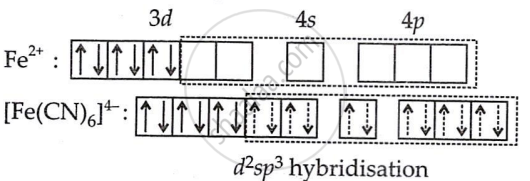Advertisements
Advertisements
प्रश्न
Discuss the nature of bonding in the following coordination entity on the basis of valence bond theory:
[Fe(CN)6]4−
उत्तर
The oxidation state of iron in this complex ion is +2.
Electronic configuration of Fe = [Ar] 3d64s2
Electronic configuration of Fe2+ = [Ar] 3d6
The iron (II) ion must provide six vacant orbitals to accommodate the six electron pairs from the six cyanide ions. This can be achieved by the hybridisation method in which the electrons of the d-subshell get paired since the CN– ions are strong field ligands.

Hence, six electron pairs from six cyanide ions occupy six hybrid orbitals of iron (II) ion. Thus, no unpaired electrons are in any orbital, so [Fe(CN)6]4− shows diamagnetism. Hence, [Fe(CN)6]4− is diamagnetic and octahedral.
APPEARS IN
संबंधित प्रश्न
[Cr(NH3)6]3+ is paramagnetic while [Ni(CN)4]2− is diamagnetic. Explain why?
Discuss the nature of bonding in the following coordination entity on the basis of valence bond theory:
[FeF6]3−
Discuss the nature of bonding in the following coordination entity on the basis of valence bond theory:
[CoF6]3−
Write the hybridisation and number of unpaired electrons in the complex `[CoF_6]^(3-)`. (Atomic No. of Co = 27)
Using valence bond theory, explain the following in relation to the complexes given below:
\[\ce{[Co(NH3)6]^{3+}}\]
(i) Type of hybridisation.
(ii) Inner or outer orbital complex.
(iii) Magnetic behaviour.
(iv) Spin only magnetic moment value.
Using valence bond theory, explain the following in relation to the complexes given below:
\[\ce{[FeCl6]^{4-}}\]
(i) Type of hybridisation.
(ii) Inner or outer orbital complex.
(iii) Magnetic behaviour.
(iv) Spin only magnetic moment value.
The type of hybridization involved in Octahedral complexes is ______.
Write the hybridization and shape of the following complexes:
[Ni(CN)4]2−
In a coordination entity, the electronic configuration of the central metal ion is t2g3 eg1
Is the coordination compound a high spin or low spin complex?
If orbital quantum number (l) has values 0, 1, 2 and 3, deduce the corresponding value of principal quantum number, n.
How many radial nodes for 3p orbital?
Which of the statement given below is incorrect about H2O2?
As the s-character of hybridised orbital increases, the bond angle
Which of the following methods is used for measuring bond length?
Which of the following has square planar structures?
Valence bond theory is based on the assumption that the bonds formed between the metal ions and ligands are ______
Using valence bond theory, predict the hybridization and magnetic character of the following:
[CoF6]3– [Atomic number of Co = 27]
Write the hybridisation and magnetic behaviour of [CoF6]3−.
[Given: Atomic number of Co = 27]
The magnetic moment of [NiCl4]2− is ______.
[Atomic number: Ni = 28]
